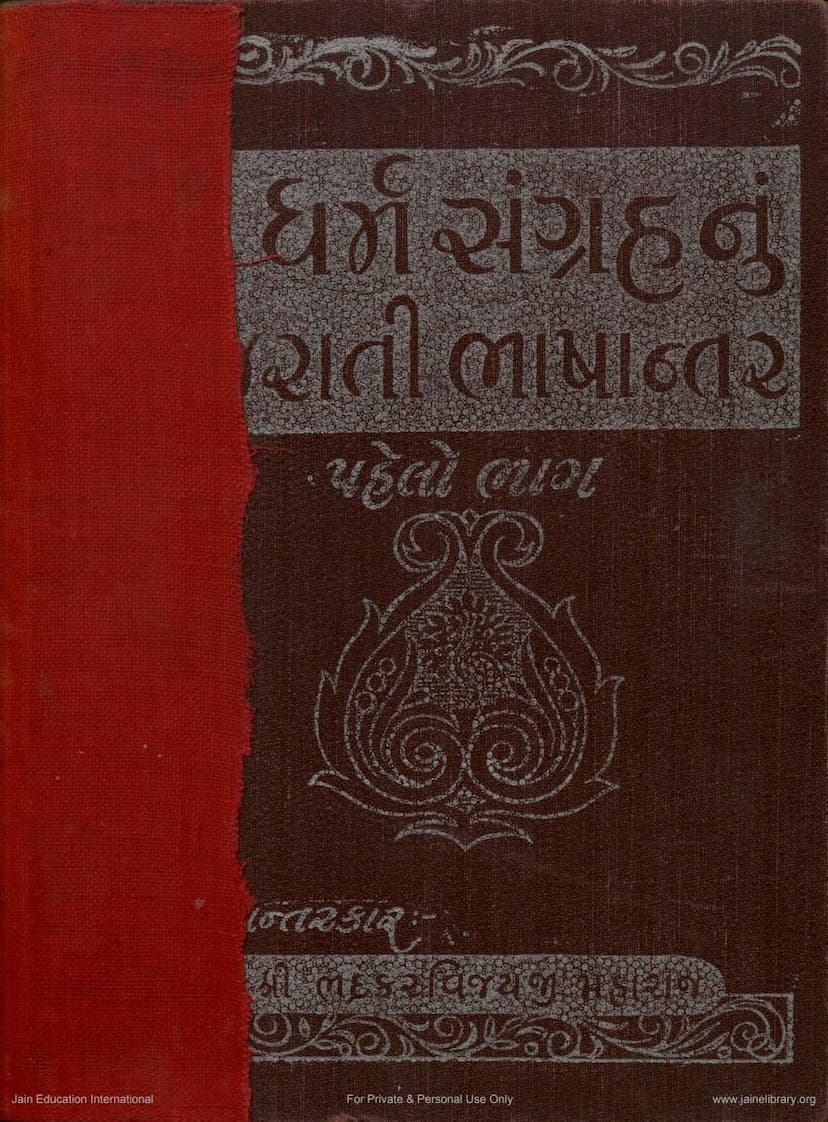Dharmasangraha Part 1
Added to library: September 1, 2025

Summary
This document is the first part of the Dharmasangraha (Collection of Dharma) by Bhadrankarvijay, published by Amrutlal Jesinghbhai Shah. It appears to be a Gujarati translation of a larger Jain text, with a commentary (Tika) and an introduction or exposition titled "Prarthana" and "Udbodhan."
Here's a breakdown of the key themes and content covered in the provided pages:
Overall Purpose: The text emphasizes the necessity of scriptures (Shastra) for understanding true happiness and liberation from suffering. It argues that although all living beings strive for happiness, most are ignorant of its true nature and the path to achieve it. Scriptures, originating from enlightened beings (Tirthankaras and Ganadharas), provide this essential knowledge. The book Dharmasangraha itself is presented as a compilation of the essence of various ancient scriptures, making profound spiritual principles accessible to modern readers.
Core Jain Philosophy Explained:
- Happiness and Suffering: The text posits that all actions of a living being are ultimately for the sake of happiness. However, due to ignorance, beings have been unable to attain lasting happiness since time immemorial.
- The Role of Scriptures: Scriptures are essential because they identify the true nature of happiness and the means to acquire it, which the soul (Jiva) is otherwise ignorant of. They are considered an infallible guide for liberation from suffering.
- The Root of Suffering: The text identifies the primary causes of suffering as the soul's entanglement with gross matter (pudgala). This entanglement stems from four basic instincts: ahar (food), bhay (fear), maithun (sex), and parigrah (possessions). These lead to intoxication from food, fear of separation or unwanted union, intense attachment to sensual pleasures, and strong attachment to acquired or unacquired possessions. In Jain terminology, this state is called avirati (non-restraint).
- The Path to Liberation (Virati): The counteracting forces to these instincts, and thus the path to liberation from suffering, are anahar (non-food), nirbhaya (fearlessness), vishaya virag (detachment from sensual pleasures), and nisangatva (non-possession/non-attachment). In Jain terms, this is called virati (restraint).
- Knowledge and Conduct: The text stresses that knowledge from scriptures is not for mere accumulation but for controlling material desires and achieving liberation. Knowledge without ethical conduct (sadachar) is deemed fruitless, akin to darkness. Similarly, conduct without the goal of liberation is mere physical exertion and not true conduct.
- Gradual Development: The book outlines a step-by-step approach to controlling desires and developing inner virtues, starting from the initial stages of householder life up to the highest spiritual attainments.
Key Aspects of Dharmasangraha (Part 1):
- Content: The book aims to provide a simple yet profound description of how to achieve self-development and the resulting bliss. It covers essential ethical principles for householders, daily conduct, and the relationship between worldly affairs and ultimate liberation.
- Structure: The first part of the book focuses on the general dharma (duties/principles) for householders. It describes 35 specific virtues and explains how everyday activities like eating, living, working, and managing family are interconnected with the ultimate goal of liberation from suffering. It emphasizes the importance of righteous conduct as the foundation for spiritual liberation.
- Key Themes Explored in Detail:
- 35 Virtues: The text elaborates on 35 general virtues for householders, highlighting their necessity in modern society. The absence of these virtues leads to attachment to falsehood instead of truth.
- Righteous Conduct: It explains how to achieve true happiness through practice, starting from samaktva (right faith/belief) and proceeding through various stages of vows (vrata) for householders.
- Daily Schedule: The book details a daily routine, from waking up to evening activities, emphasizing the proper way to perform even mundane tasks in the context of dharma.
- Service to Deva, Guru, and Dharma: It discusses the importance of serving the divine, the spiritual preceptors, and dharma itself.
- Ethical Living: It outlines how to earn wealth justly, manage finances according to income, serve parents, associate with virtuous people, be grateful, eat at appropriate times, and serve learned elders.
- Spiritual Path: The text guides the reader on how to develop truthfulness, avoid false beliefs, and embrace virtues that lead to the ultimate realization of truth and liberation.
- Practical Advice: It offers practical guidance on various aspects of life, including how to conduct oneself in society, maintain ethical behavior, and understand the principles of dharma in relation to achieving happiness.
- Authorship and Editing: The original text was composed in Sanskrit verse by Mahopadhyaya Shri Manvijayaji Ganivar in 1731 VS. The research and editing were meticulously done by Mahopadhyaya Shri Yashovijayaji Ganivar, a renowned scholar. The Gujarati translation was undertaken by Muni Shri Bhadraṅkaravijayaji Maharaj. The text also acknowledges the contributions of Acharya Shri Vijay Siddhisuriji Maharaj and Acharya Shri Vijay Meghsurisuriji Maharaj.
- Significance: The book is considered a valuable treasure trove of ancient Jain wisdom, compiled for the benefit of humanity. It bridges the gap between ancient teachings and modern understanding, offering practical guidance for spiritual progress and a happy life. It addresses controversial topics within Jainism based on ancient texts, providing clear and impartial explanations.
Target Audience and Impact: The book is intended for anyone seeking happiness and liberation. It's particularly useful for householders aiming to integrate spiritual principles into their daily lives. The author expresses hope that readers, upon understanding its contents, will accept its truths wholeheartedly.
In essence, Dharmasangraha Part 1 is a comprehensive guide to understanding and practicing Jain dharma, presented in a clear and accessible manner, aiming to lead individuals towards spiritual well-being and ultimate liberation.